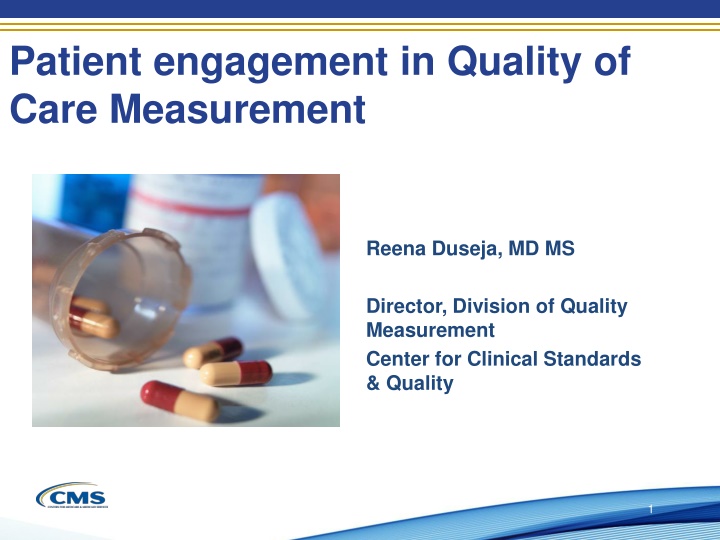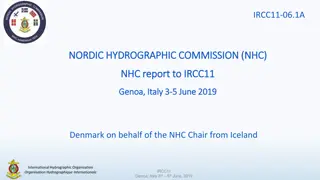
Patient Engagement in Quality of Care Measurement Strategies
Explore strategies for patient engagement in quality measurement, including alignment with CMS strategy, prioritizing patient-centered outcomes, and developing measures in clinical care, care coordination, and population health. Learn how to incorporate patient preferences, ensure scientific rigor, and monitor disparities to enhance care quality.
Download Presentation

Please find below an Image/Link to download the presentation.
The content on the website is provided AS IS for your information and personal use only. It may not be sold, licensed, or shared on other websites without obtaining consent from the author. If you encounter any issues during the download, it is possible that the publisher has removed the file from their server.
You are allowed to download the files provided on this website for personal or commercial use, subject to the condition that they are used lawfully. All files are the property of their respective owners.
The content on the website is provided AS IS for your information and personal use only. It may not be sold, licensed, or shared on other websites without obtaining consent from the author.
E N D
Presentation Transcript
Patient engagement in Quality of Care Measurement Reena Duseja, MD MS Director, Division of Quality Measurement Center for Clinical Standards & Quality 1
General Principles Alignment with CMS Quality Strategy Alignment with Commercial payers and states Address performance gaps Evidence-based measure concepts Scientific rigor Patient/caregiver and front line clinician inclusion Rapid-cycle development Prioritize Patient-reported outcomes Monitor disparities and unintended consequences 2
Strategic Vision Measures should be: Patient Centered with a focus on patient experience and preferences High Valuewith an emphasis on outcomes for patients and spanning the care continuum Current with clinical practice updates Applicable to other payers and across care settings Agilein their development, with an emphasis on innovation
Priorities for Measure Development by Quality Domain Clinical Care Measures incorporating shared decision-making Outcome and Patient-reported Outcome Measures Cross-cutting measures (patients with MCCs) Focused measures for specialties that have clear gaps Safety Measures of diagnostic accuracy Medication safety 4
Priorities for Measure Development by Quality Domain (continued) Care Coordination Assessing team-based care Effective use of new technologies Patient and Caregiver Experience Disease specific and cross-cutting PROMs Patient experience surveys (general and specialty-specific where needed) 5
Priorities for Measure Development by Quality Domain (continued) Population Health and Prevention Developing or adapting outcome measures at a population level to assess the effectiveness of the health promotion and preventive services delivered by professionals Affordable Care Overuse measures Episode based resource use 6
Person & Family Engagement Network Composition Fiscal Year 2017 began with 43 members and as of 9/1/17 has 68 members 6% 25% 41% 28% Patient Family Caregiver Adovcate Consumer 7
Conditions Represented in Person and Family Engagement Network Member Experiences Palliative and end-of-life care; advance directives Cardiac Care: heart attack and failure, coronary artery disease, heart transplant, cardiac rehab Cancer Care: breast cancer, non-Hodgkin s lymphoma, colorectal cancer, ovarian cancer Family Caregiving Disability/Chronic Illness: multiple sclerosis, spinal muscular atrophy, Spastic quadriplegia Cerebral Palsy, Ehlers-Danlos syndrome, down syndrome, kidney disease, endometriosis, chronic pain Health care chaplaincy/ministry Mental health conditions and comorbidities Hip/joint replacement Diabetes Health care disparities: race, ethnicity, socioeconomic status, sexual orientation Aging Patient Safety 8
Engagement mechanisms CMS uses in Patient Engagement Technical Expert Panels Network-Wide Surveys Targeted one to one cognitive interviews Listening sessions and Surveys Targeted Working Group and Survey 9
Role of Patient Reported Outcome (PRO) Measures Consistent with the National and CMS Quality Strategies, CMS has embarked on multiple PRO-based measure development projects These projects have created opportunities for engaging stakeholders and advancing clinical practice, which has been traditionally slow to incorporate PROs. 10
Using PRO data to build quality measures ensures that patient s voice is heard. The voluntary PRO data collection in the Comprehensive Care for Joint Replacement model is the first demonstration that hospitals recognize the value and importance of collecting PRO data. Patient s self-reported pain and functional outcomes after elective knee and hip arthroplasty 11
Lessons learned Partnering with persons and families means operating outside the Nine-Five day Persons & families have differing needs, preferences, and expectations from one another Persons & families know best how they should be engaged Language impacts relationship building and engagement success 12
Lessons Learned Person & Family Engagement vision and impact One-time Network-wide engagements can have significant impacts Successful engagement requires an organization-wide person & family engagement vision 13
Contact Information Reena Duseja, M.D., MS Director, Division of Quality Measurement, Center for Clinical Standards and Quality Chief Medical Officer Centers for Medicare and Medicaid Services Reena.Duseja@cms.hhs.gov

















